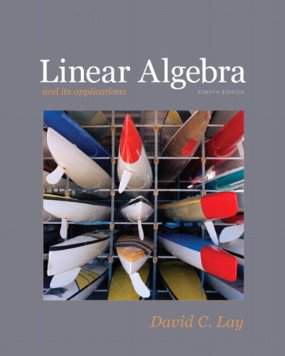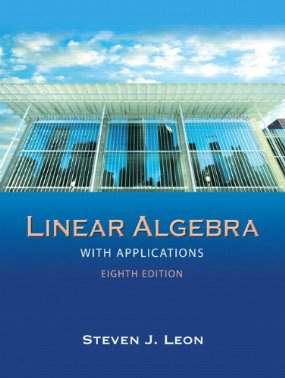Connecting...

This is a quick preview of the lesson. For full access, please Log In or Sign up.
For more information, please see full course syllabus of Linear Algebra
For more information, please see full course syllabus of Linear Algebra
Linear Algebra Spanning Set for a Vector Space
Lecture Description
You may be wondering if you’ll ever apply your knowledge of spaces and subspaces to a problem. Here we’ll use what we learned in the last video to teach you how to test if a vector ‘spans’ a space. What we mean by that is if a group of vectors can be combined linearly to represent every vector in a given space. This is a relatively short topic, and is more math-based than proof-based, so it will serve as a nice break from the heavy definitions we’ve been giving you. We’ll follow this with another short topic of linear independence.
Bookmark & Share
Embed
Share this knowledge with your friends!
Copy & Paste this embed code into your website’s HTML
Please ensure that your website editor is in text mode when you paste the code.(In Wordpress, the mode button is on the top right corner.)
×
Since this lesson is not free, only the preview will appear on your website.
- - Allow users to view the embedded video in full-size.
Next Lecture
Previous Lecture










































 Answer Engine
Answer Engine




1 answer
Wed Oct 26, 2016 7:58 PM
Post by Kaye Lim on September 23, 2016
For example 1, If I choose a specific number for the random vector (a,b,c), then I will get a specific number value for (c1,c2,c3). Because the solution of (c1,c2,c3) exists, we conclude that the given 3 vectors v1,v2 and v3 span the vector space R^3.
However, for example 4, we got infinite number of solution for (x1,x2,x3,x4). I thought we would conclude that the set of 4 given vectors (1,-2,1,4),(1,-2,1,4),(0,1,-1,-1) and (2,5,3,9) would span the Null space as in example 1. Why in example 4, the solution vectors span the Null space instead of the 4 given vectors?
1 answer
Wed Sep 2, 2015 11:44 PM
Post by Alexander Tetreault on August 31, 2015
Hi Raffi,
I am somewhat confused by the definition of 'span', it seems as though it has two meanings. In the subspaces video you defined it as the
"set of all linear combinations of the elements in S" while in this video it was defined as being the set of vectors by which all other vectors are a linear combination of. Basically, by my understanding, one means the set of elements created while the other means the set of vectors that do the creating. Could you please clarify?
2 answers
Last reply by: Growth Mindset Believer
Sun Apr 3, 2016 11:44 PM
Post by Growth Mindset Believer on May 19, 2015
This is not a question. I just wanted to say thank you for your lectures. I've gained so much from watching them. Often in mathematics I can understand how to do something computationally without understanding the underlying meaning of what I'm doing. However, after watching your videos multiple times I've gained a much deeper understanding of linear algebra, which is helping me a great deal with the linear algebra course that I'm currently enrolled in.
What I usually do is watch your lecture before reading the section of the book that I'm working on. Then, I try a few examples and go back and watch your lecture again to gain a deeper understanding of what I've done. Maybe some students only need to hear something once in order to fully understand it, but I've found that repetition of concepts and regular practice tend to be the only ways in which I can get an A in a course, especially as I've gone higher in mathematics and the material has gotten more complicated.
This is why online lectures such as yours are so great since I can watch them however many times as I want whereas any instructors will grow tired of explaining something multiple times in person, and I tend to worry that I'm holding back the rest of the class from learning if I ask too many questions in a real life lecture hall since time is limited and the professor has to get through his or her lesson plan. These issues do not exist with online lectures; if I don't understand a concept, I just watch it again until I get it.
This is also part of the beauty of mathematics, since going over past material can shed light on new concepts that I didn't understand the first time around, so it's like a well that I can continually draw water from. I also prefer your lectures over the ones I find on youtube since you are a trained mathematician who has taught higher education courses so your teaching style is refined and your lectures are well structured, as opposed to a lot of the videos I'll find on youtube where the person doesn't really have a good grasp of the material and just skips to computation without explaining what they are doing.
Lastly, I appreciate your personality. You come across as a kind uncle type; I can't detect a hint of arrogance in your personality as opposed to many of my real life professors who act like the students are beneath them. Thank you again for making your videos and sorry for writing such a long post, I just wanted to thank you for helping me with my linear algebra course this semester.
2 answers
Last reply by: Christian Fischer
Tue Oct 1, 2013 2:24 AM
Post by Christian Fischer on September 25, 2013
Hi Raffi: Just a question for example 4. Is it correctly understood that Since we have 2 free parameters "s" and "t" this does NOT mean we have a infinate number of vectors in our nullspace because t*(-1,1,0,0) (our solution vector) is the same vector no matter what value of t we use (it has the same direction and can just be scaled up and down)??
So i mean (-1,1,0,0) is the same vector as (-5,5,0,0)?
4 answers
Wed Sep 25, 2013 4:57 PM
Post by Manfred Berger on June 15, 2013
I have a question regarding example 2: Since P_1(t) and P_2(t) are both second degree polynomials,there are no vectors present in this set to span any vector below degree 2. Isn't it therefor obvious that this can't be a spaning set for the entire space even before checking it formally?
2 answers
Tue Feb 19, 2013 12:43 AM
Post by Megan Kell on February 17, 2013
at 21:00 you say that the only way this solution could be consistent is if b-4a+2c = 0, and the only way that this is possible is if b, a, and c are all zero, and since that would be a trivial solution, this system is inconsistent and therefore has no solution. Why can't b=0, a=1 and c=2? This would also cause b-4a+2c = 0-4(1)+2(2)=0 and it would not be a trivial solution, thus allowing the system to be consistent. Why is this not possible?